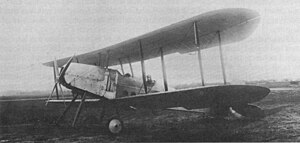Royal Aircraft Factory R.E.5
| Royal Aircraft Factory R.E.5 | |
|---|---|

| |
| Role | Reconnaissance and artillery observation biplane |
| Manufacturer | Royal Aircraft Factory
|
| First flight | 1914 |
| Introduction | 1914 |
| Primary user | Royal Flying Corps |
| Number built | 24 |
| Variants | Royal Aircraft Factory R.E.7 |
The Royal Aircraft Factory R.E.5 was a British two-seat reconnaissance and artillery observation biplane designed and built by the
Development
The R.E.5 was designed as a reconnaissance biplane using the experience of earlier R.E. series aircraft. It was a two-bay equal-span biplane with a fixed tailskid landing gear, with the wheels supported on skids and powered by a nose-mounted 120 hp (89 kW)
Twenty four R.E.5s were built at the Royal Aircraft Factory for the RFC, paid for by money given to the British Army to compensate for the transfer of the army's airships to the Royal Navy.[3]
Operational history
Six R.E.5s deployed to France in September 1914, partly equipping No. 2 Squadron RFC, with further examples being by other squadrons, with no unit being completely equipped with the R.E.5. In total, eleven R.E.5s were sent to France, with a further nine being used by training units.
The R.E.5s were used for reconnaissance and bombing missions over France, although at first they were not fitted with bomb-sights or bomb racks, bombs being carried in the observer's cockpit and dropped by hand when the aircraft was over the target.[3]

One of the aircraft with extended upper wings set a new world altitude record of 18,900 ft (5,760 m) on 14 May 1914, piloted by Norman Spratt.[1]
Operator
Specifications
General characteristics
- Crew: 2 (pilot, observer/gunner)
- Length: 26 ft 2 in (7.98 m) [4]
- Wingspan: 44 ft 6 in (13.57 m) [4]
- Height: 9 ft 8 in (2.95 m)
- Wing area: 498 sq ft (46.3 m2)
- Powerplant: 1 × Austro-Daimler piston engine , 120[4] hp (89 kW)
Performance
- Maximum speed: 78 mph (126 km/h, 68 kn) [4]
Armament
- 3 × 20 lb (9 kg) bombs
See also
Related lists
References
Notes
Bibliography
- Bruce, J.M. (1957). British Aeroplanes 1914-18. London: Putnam.
- Bruce, J.M. (1992). The Aeroplanes of the Royal Flying Corps (Second ed.). London: Putnam. ISBN 0-85177-854-2.
- Klaauw, Bart van der (March–April 1999). "Unexpected Windfalls: Accidentally or Deliberately, More than 100 Aircraft 'arrived' in Dutch Territory During the Great War". Air Enthusiast (80): 54–59. ISSN 0143-5450.
- Lewis, Peter (1974). The British Bomber since 1914 (Second ed.). London: Putnam. ISBN 0-370-10040-9.
Further reading
- Taylor, Michael J. H. (1989). Jane's Encyclopedia of Aviation. London: Studio Editions.
- The Illustrated Encyclopedia of Aircraft (Part Work 1982-1985). Orbis Publishing. p. 2820.
